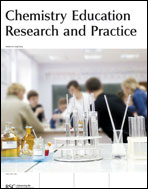Student-generated submicro diagrams: a useful tool for teaching and learning chemical equations and stoichiometry
Abstract
This paper reports on a pedagogical approach to the teaching of chemical equations introduced to first year university students with little previous chemical knowledge. During the instruction period students had to interpret and construct diagrams of reactions at the submicro level, and relate them to chemical equations at the symbolic level with the aim of improving their conceptual understanding of chemical equations and stoichiometry. Students received instruction in symbol conventions, practice through graded tutorial tasks, and feedback on their efforts over the semester. Analysis of the student responses to formative test and summative exam items over consecutive years indicates that there was a consistent improvement in the abilities of the various cohorts to answer stoichiometry questions correctly. The responses provide evidence for diagrams of the submicro level being used as tools for reasoning in solving chemical problems, to recognise misconceptions of chemical formulae and to recognise the value of using various multiple representations of chemical reactions connecting the submicro and symbolic levels of representation. The student-generated submicro diagrams serve as a visualisation tool for teaching and learning abstract concepts in solving stoichiometric problems. We argue that the use of diagrams of the submicro level provides a more complete picture of the reaction, rather than a net summary of a chemical equation, leading to a deeper conceptual understanding.

 Please wait while we load your content...
Please wait while we load your content...